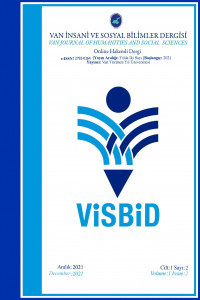More than one modernism: a journey through James Joyce, Virginia Woolf and Wyndham Lewis
Modernist movement in arts and fiction dates back to the end of the nineteenth century. However, it was attributed to different decades in different countries by various critics. Modernist fiction in England displayed various characteristics differing from one another. This study explores the characteristics of modernist fiction as practiced in the works of Virginia Woolf, James Joyce and Wydham Lewis. These three monumental modernist authors wrote in distinctively experimental styles all of which differed largely from one another despite the similarities in their modernist techniques. The experimental language uses and stream of consciousness by James Joyce stood out among the others while Virginia Woolf’s language use and stream consciousness exhibited her own untraditional content. The purpose of this study is to argue that there are more than one modernism and these modernisms are not equal.
___
- Alexander, Marguerite. (1990). Flights from realism: Themes and strategies of British and American fiction. London: Ashgate Publishing.
- Bergonzi, Bernard. (1986). The myth of modernism and twentieth century literature. Michigan: The Harvester Press.
- Bradbrook, M.C. (1982). Women & Literature: The collected papers of Muriel Bradbrook Vol.2. Sussex: The Harvester Press.
- Bradbury, M. & McFarlane, J. (ed.) (1991). Modernism: A guide to European literature 1890-1930. London: Penguin.
- Brooker, Peter. (1992). “Introduction: Reconstructions”, in Brooker, P. (ed.) Modernism/Postmodernism. London: Longman. 1-25.
- Brown, Dennis. (1990). Intertextual dynamics within the literary group - Joyce, Lewis, Pound & Eliot. London: MacMillan.
- Butler, Christopher. (1994). Early modernism: Literature, music, and painting in Europe 1900-1016. Oxford: Clarendon Press.
- Decaudin, Michel. (1986). “Being modern in 1885 or variations on ‘Modern’, ‘Modernism’, ‘Modernité’” in Chefdar, M., Quinones, R. & Wachtel, A. (ed.). Modernism, challenges & perspectives. Urbana: University of Illinois Press. 25-32.
- Eco, Umberto. (1992). “Postmodernism, irony, the enjoyable”, in Brooker, P. (ed.) Modernism/Postmodernism, London: Longman. 225-29.
- Faulkner, Peter. (1993). Modernism. London & New York: Routledge.
- Friedman, M.J. (1991). “The symbolist novel: Huysmans to Malraux”. in Bradbury, M. & McFarlane, J. (ed.). Modernism: A guide to European literature 1890-1930. London: Penguin. 453-66.
- Joyce, James. (2010). Ulysses. London: Wordsworth.
- Kenner, Hugh. (1973). The Pound Era. California: University of California Press.
- Kermode, F. & Hollander, J. (1973). Modern British literature. Oxford: Oxford University Press.
- Lewis, Wydham. (2010) Tarr. Oxford: Oxford University Press.
- Ousby, Ian. (1995). The Wordsworth companion to literature in English. London: Wordsworth Reference.
- Scott, Clive. (1991). “The prose poem and free verse,” in Bradbury, M. & McFarlane, J. (ed.). Modernism: A guide to European literature 1890-1930. London: Penguin. 349-368.
- Spender, Stephen. (1963). The struggle of the modern. London: Hamish Hamilton.
- Stevenson, Randall. (1992). Modernist fiction. London: Harvester/Wheatsheaf.
- Symons, Julian. (1987). Makers of the new: The revolution in literature. London: Andre Deutsch.
- Wohl, Robert. (1986). “The generation of 1914 and modernism”. in Chefdar, M., Quinones, R. & Wachtel, A. (ed.). Modernism, challenges & perspectives, Urbana: University of Illinois Press. 66-78.
- Woolf, Virginia. (2012). The Waves. London: Wordsworth Classics.
- Başlangıç: 2021
- Yayıncı: Van Yüzüncü Yıl Üniversitesi
Sayıdaki Diğer Makaleler
Van Şehir Gelişimi ile Şehir Isı Adası Arasındaki İlişkiler ve Sıcaklık Değişimleri
Murathan Mungan’ın Nihayet ve Saklı Yas Öyküleri Üzerine
More than one modernism: a journey through James Joyce, Virginia Woolf and Wyndham Lewis
Van İli Yüzey Araştırması Kapsamında Doğu Anadolu Bölgesi Paleolitik Çağ Kalıntıları
